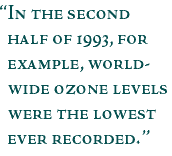

|
The term "ozone depletion" means more than just the natural destruction of ozone, it means that ozone loss is exceeding ozone creation. Think again of the "leaky bucket." Putting additional ozone-destroying compounds such as CFCs into the atmosphere is like increasing the size of the holes in our "bucket" of ozone. The larger holes cause ozone to leak out at a faster rate than ozone is being created. Consequently, the level of ozone protecting us from ultraviolet radiation decreases. During the last 15 years, an additional mechanism was found in the areas over the Antarctic and Arctic that rapidly destroys ozone. Over the Earth's poles during their respective winters, the stratosphere cools to very cold temperatures and polar stratospheric clouds (PSCs) form. In the polar stratosphere, nearly all of the chlorine is in the form of inactive or "reservoir" gases such as hydrogen chloride (HCl) and chlorine nitrate (ClONO2) that do not react with ozone or each other. However, chemical reactions of these "reservoir" chlorine gases can occur on the polar stratospheric cloud particle surfaces, converting the chlorine gases into very reactive forms that rapidly destroy ozone. This "polar chemistry" on the stratospheric cloud particles has caused very large decreases in ozone concentrations over Antarctica and the Arctic. In fact, ozone levels drop so low in spring over Antarctica that scientists describe this loss as the "Antarctic Ozone Hole."
next: Monitoring Ozone from Space |

Ozone |